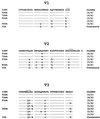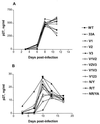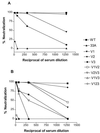Selection for neutralization resistance of the simian/human immunodeficiency virus SHIVSF33A variant in vivo by virtue of sequence changes in the extracellular envelope glycoprotein that modify N-linked glycosylation
- PMID: 10364275
- PMCID: PMC112584
- DOI: 10.1128/JVI.73.7.5294-5300.1999
Selection for neutralization resistance of the simian/human immunodeficiency virus SHIVSF33A variant in vivo by virtue of sequence changes in the extracellular envelope glycoprotein that modify N-linked glycosylation
Abstract
We previously reported on the in vivo adaptation of an infectious molecular simian/human immunodeficiency virus (SHIV) clone, SHIVSF33, into a pathogenic biologic viral variant, designated SHIVSF33A. In the present study, we show that SHIVSF33A is resistant to neutralization by human immunodeficiency virus (HIV) and SHIV antisera. Multiple amino acid substitutions accumulated over time throughout the env gene of SHIVSF33A; some of them coincided with the acquisition of the neutralization resistance of the virus. Of interest are changes that resulted in the removal, repositioning, and addition of potential glycosylation sites within the V1, V2, and V3 regions of envelope gp120. To determine whether potential glycosylation changes within these principal neutralization domains of HIV type 1 formed the basis for the resistance to serum neutralization of SHIVSF33A, mutant viruses were generated on the backbone of parental SHIVSF33 and tested for their neutralization sensitivity. The mutations generated did not alter the in vitro replication kinetics or cytopathicity of the mutant viruses in T-cell lines. However, the removal of a potential glycosylation site in the V1 domain or the creation of such a site in the V3 domain did allow the virus to escape serum neutralization antibodies that recognized parental SHIVSF33. The combination of the V1 and V3 mutations conferred an additive effect on neutralization resistance over that of the single mutations. Taken together, these data suggest that (i) SHIV variants with changes in the Env SU can be selected in vivo primarily by virtue of their ability to escape neutralizing antibody recognition and (ii) carbohydrates play an important role in conferring neutralization escape, possibly by altering the structure of envelope gp120 or by shielding principal neutralization sites.
Figures




References
-
- Albert J, Abrahamsson B, Nagy K, Aurelius E, Gaines H, Nystrom G, Fenyo E M. Rapid development of isolate-specific neutralizing antibodies after primary HIV-1 infection and consequent emergence of virus variants which resist neutralization by autologous sera. AIDS. 1990;4:107–112. - PubMed
-
- Arendrup M, Nielsen C, Hansen J-E S, Pedersen C, Mathiesen L, Nielsen J O. Autologous HIV-1 neutralizing antibodies: emergence of neutralization-resistant escape virus and subsequent development of escape virus neutralizing antibodies. J Acquired Immune Defic Syndr. 1992;5:303–307. - PubMed
-
- Back N K, Smit L, De Jong J J, Keulen W, Schutten M, Goudsmit J, Tersmette M. An N-glycan within the human immunodeficiency virus type 1 gp120 V3 loop affects virus neutralization. Virology. 1994;199:431–438. - PubMed
-
- Benjouad A, Mabrouk K, Gluckman J C, Fenouillet E. Effect of sialic acid removal on the antibody response to the third variable domain of human immunodeficiency virus type-1 envelope glycoprotein. FEBS Lett. 1994;341:244–250. - PubMed
Publication types
MeSH terms
Substances
Grants and funding
LinkOut - more resources
Full Text Sources
Other Literature Sources

